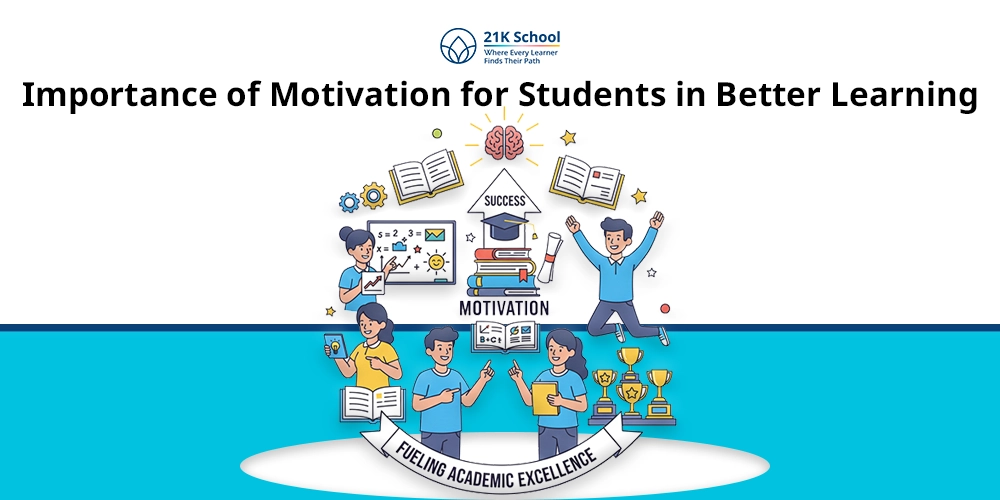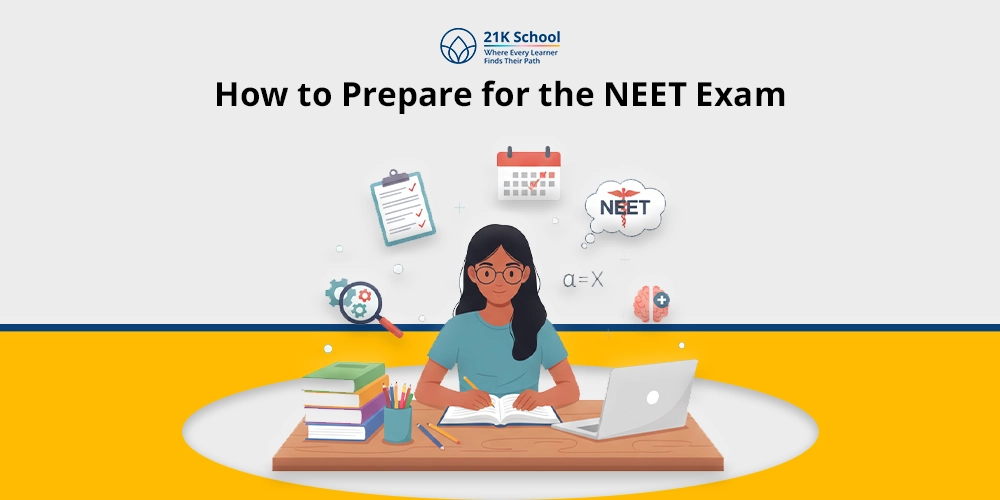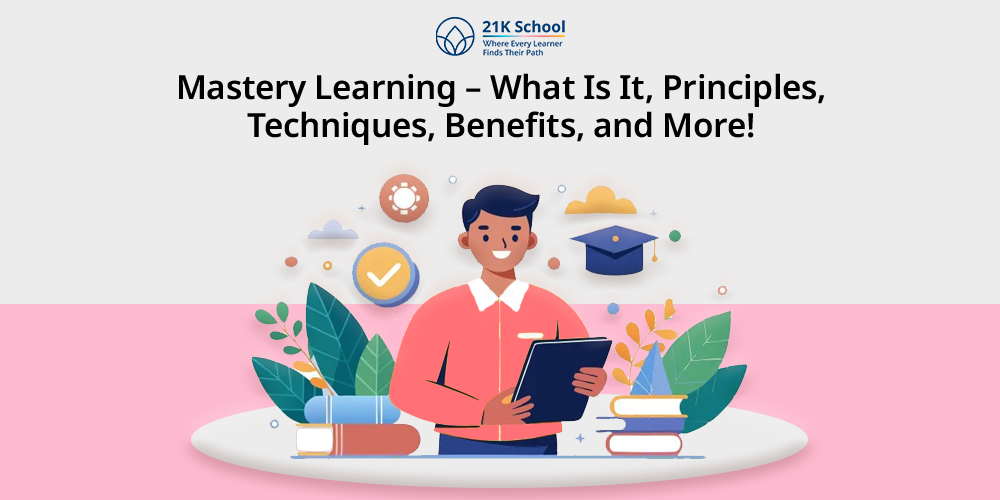
Picture a classroom with no left-behinds. All students learn at their own pace, and master profound understanding before they proceed. It is the definition of Mastery Learning.
A teaching methodology that focuses on a competency-based education process instead of focusing on time-bound information.
It is contrary to Traditional learning systems whereby students advance around the calendar being average. Whereas mastery learning will always demand that the student master a particular subject before moving on.
Educator, teacher, student, or policymaker of education; knowing about mastery learning may change your perspective on education . It is more than an approach; it is also an attitude to break the potential of all learners.
Table of Contents
- What is Mastery Learning?
- Concept of Mastery Learning
- History of Mastery Learning
- Principles of Mastery Learning
- Techniques of Mastery Learning
- Benefits of Mastery Learning
- Examples of Mastery Learning inside the Classroom
- Competency-Based Learning Vs Mastery Learning
- Challenges in Implementing Mastery Learning
- Integrating Mastery Learning with Advanced Educational Opportunities
- Concluding Comments
What is Mastery Learning?
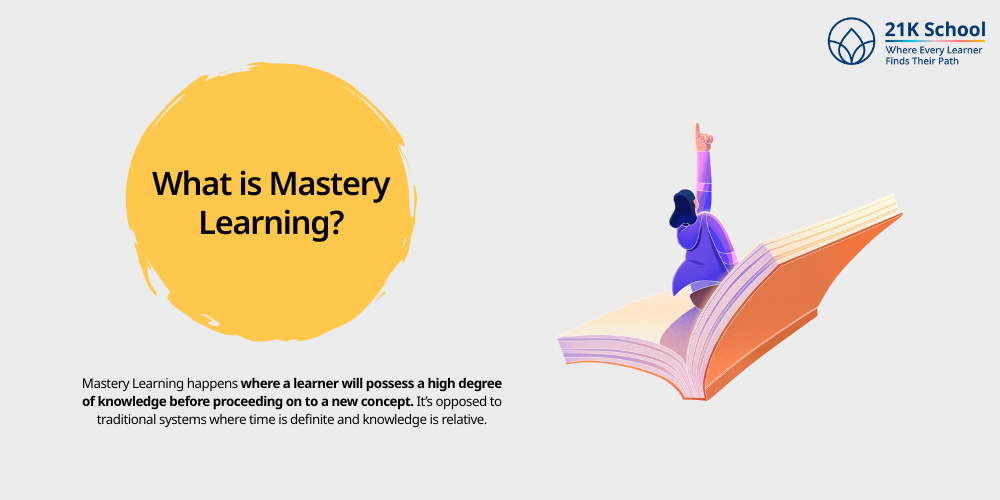
Mastery Learning happens where a learner will possess a high degree of knowledge before proceeding on to a new concept. It’s opposed to traditional systems where time is definite and knowledge is relative.
Mastery learning holds the resultant (mastery) as definite and time supports relative as required. It is about all learners achieving a high degree of demonstrated knowledge of the material.
Thus, not leaving certain students behind and letting others advance with holes in their learning. It is a student-centered approach that embraces the idea that a vast majority of learners can learn anything in academia.
This would be done only if students are provided with proper direction, adequate resources, and enough time. Mastering learning enhances educational equity since progress will be dependent on ability and not speed or comparison.
21K School provides a mastery pathway to your kids that help you excel with purpose, incorporating ease and fun in learning .
Concept of Mastery Learning
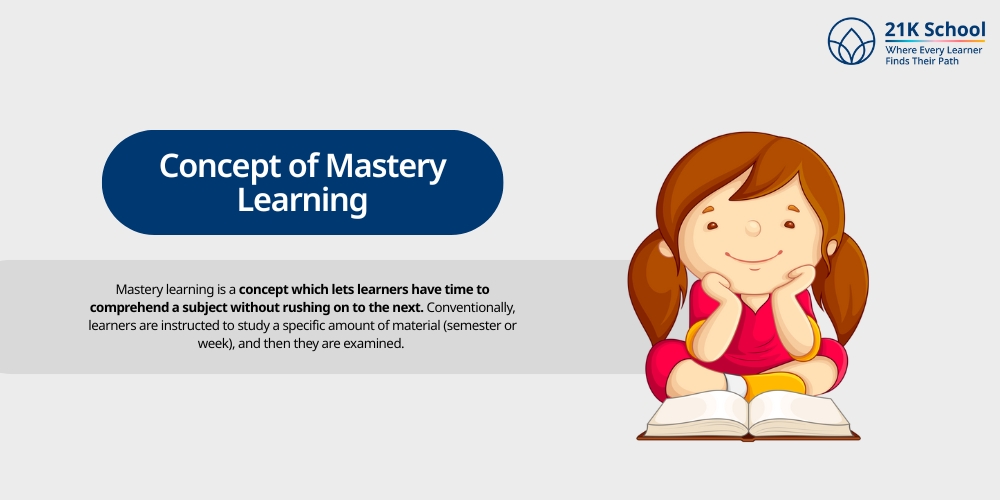
Mastery learning is a concept which lets learners have time to comprehend a subject without rushing on to the next. Conventionally, learners are instructed to study a specific amount of material (semester or week), and then they are examined.
Others are high, others are low- still all of them move on just in case they have not understood.
The important attributes of mastery learning are:
- Learning targets that clearly define what it is to become the master of a subject.
- Flexible pacing enables students to spend more or less time according to their needs.
- The formative assessments are routinely deployed to assess comprehension in the learning process.
- Feedback and clarification instruction, which enable learners to fill learning gaps.
- Expectations of all students being best, a sense that anybody can eventually succeed with the right opportunities.
Mastering learning is not only a teaching system. It is also a philosophy of learning that fosters equity, profound understanding and retention of knowledge in the long run.
History of Mastery Learning

Mastery learning came to being in the 1960s courtesy of the famous educational psychologist, Benjamin Bloom. Overall, creating the Bloom Taxonomy, a system to classify learning objectives.
Bloom was sure that the conventional education system was deeply flawed. And in its premise that only a small group of students could succeed in education.
In a normal classroom setting, Bloom noted that learners studied some specified period of time then used in a particular test. The students who got the order of the material quickly continued with the rest lagging behind.
This practice occasioned a great disparity of achievements and learning results. Bloom criticized this model and came up with another model known as Learning for Mastery.
Major Highlights of the History of Mastery Learning

1. 1968-Formal Introduction of Bloom:
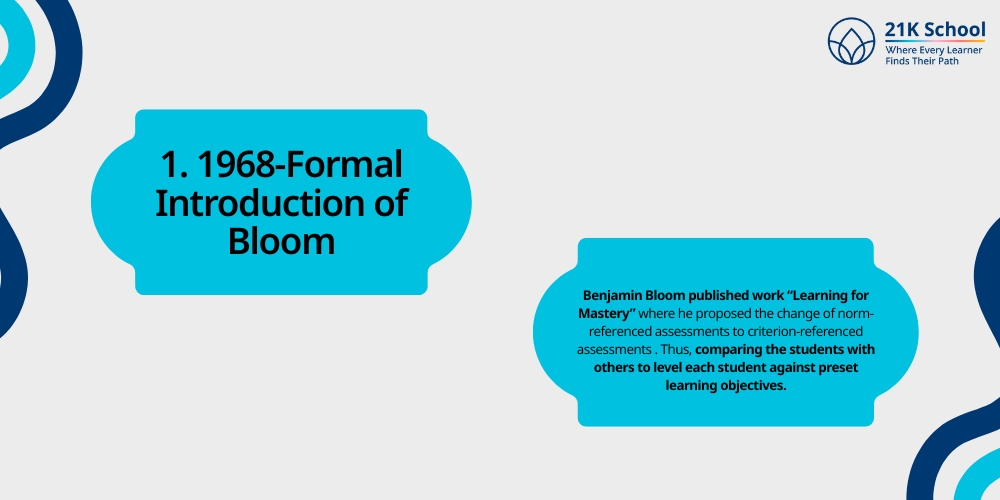
Benjamin Bloom published work “Learning for Mastery” where he proposed the change of norm-referenced assessments to criterion-referenced assessments . Thus, comparing the students with others to level each student against preset learning objectives.
His model involved loop instruction, formative assessment, correction feedback, and re-assessment.
2. 1970s-Implementation and Research:

In this era, various pilot programs and research were conducted. Especially in the United States to determine success of mastery learning. These outputs were promising.
Students in mastery-based classrooms experienced higher academic success and greater retention than their peers in traditional settings.
3. 1980s-Decline and Critique:
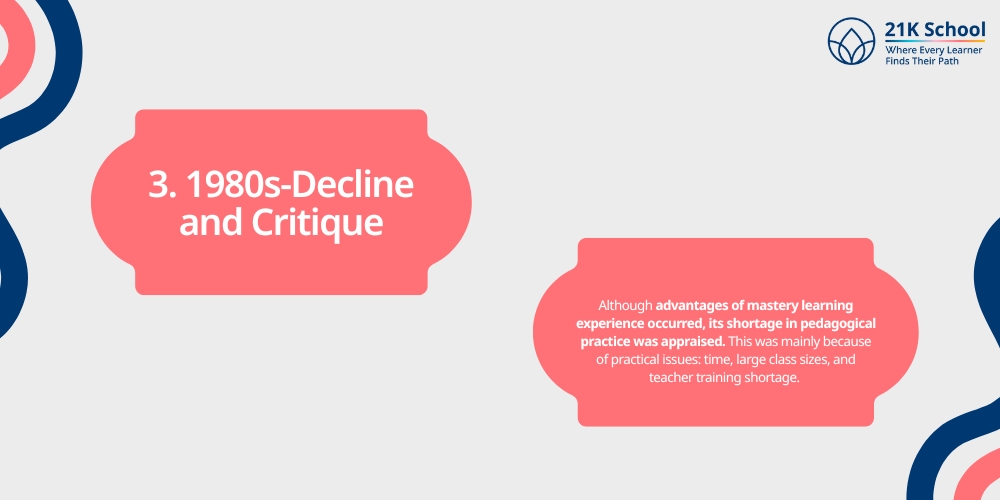
Although advantages of mastery learning experience occurred, its shortage in pedagogical practice was appraised. This was mainly because of practical issues: time, large class sizes, and teacher training shortage.
Other opponents stated it would take too much time or was not easy to apply to different classrooms in a similar way.
4. Present 1990s-Reviving with Technology:
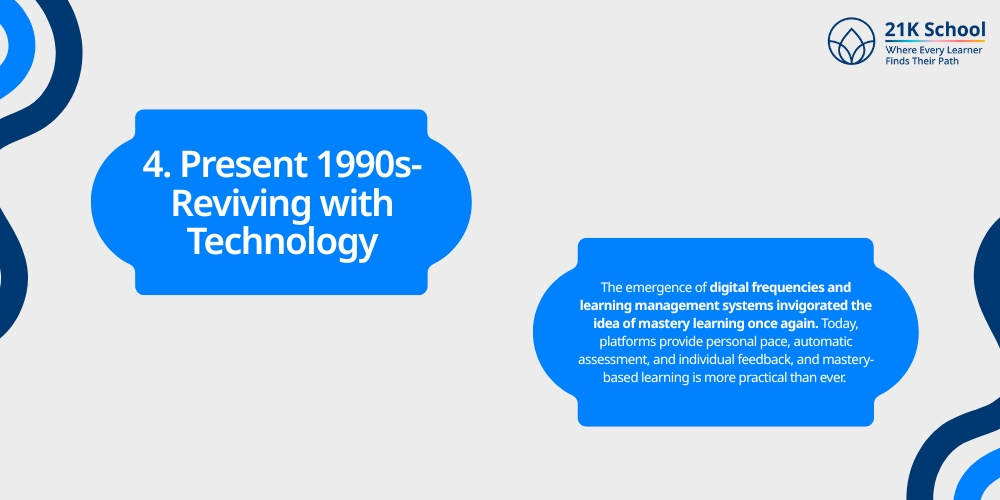
The emergence of digital frequencies and learning management systems invigorated the idea of mastery learning once again. Today, platforms provide personal pace, automatic assessment, and individual feedback, and mastery-based learning is more practical than ever.
Currently, mastery learning concepts are a staple of contemporary instructional models, like competency-based education, personalized teaching, and flipped classroom .
Principles of Mastery Learning
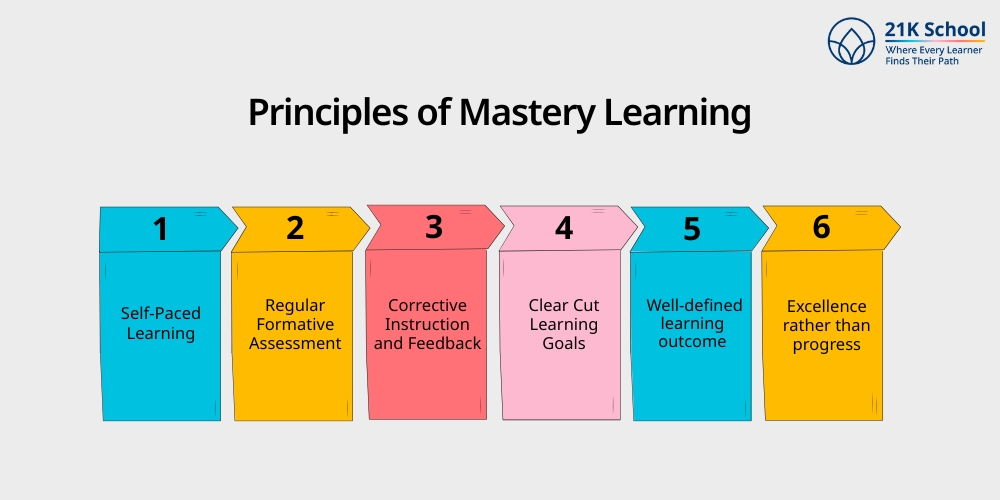
The principles of mastery learning include personalized learning , simultaneous evaluations and targeted assistance for those in need. It is all about real knowledge as opposed to completion or comparison.
Mastery learning focuses on excelling in subjects like masters before moving ahead in the syllabus . This makes the base of future learning in students.
The main components that the backbone of the mastery learning is composed of are presented below:
1. Self-Paced Learning
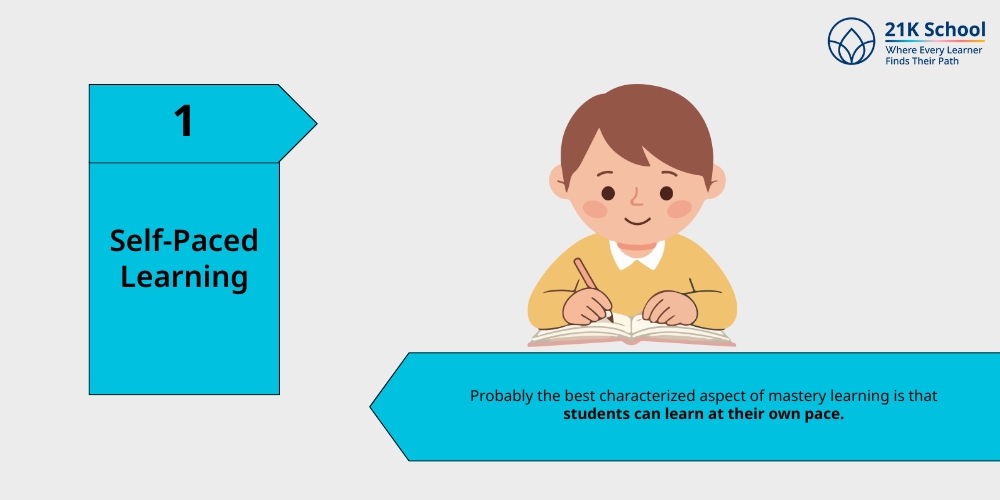
Probably the best characterized aspect of mastery learning is that students can learn at their own pace. In conventional programs, students are all required to complete tasks and examinations in a stipulated period.
This strict way of doing so does not suit different learning pace or ability. Students can actually practice self-regulated learning as a component of this. Time plays a role of a variable rather than a constant in mastery learning.
The students get a chance to review tougher concepts, practice extra, and get assistance until they have mastered the concept. This cuts down pressure and keeps one confident, and gives the students control over the learning process.
2. Regular Formative Assessment
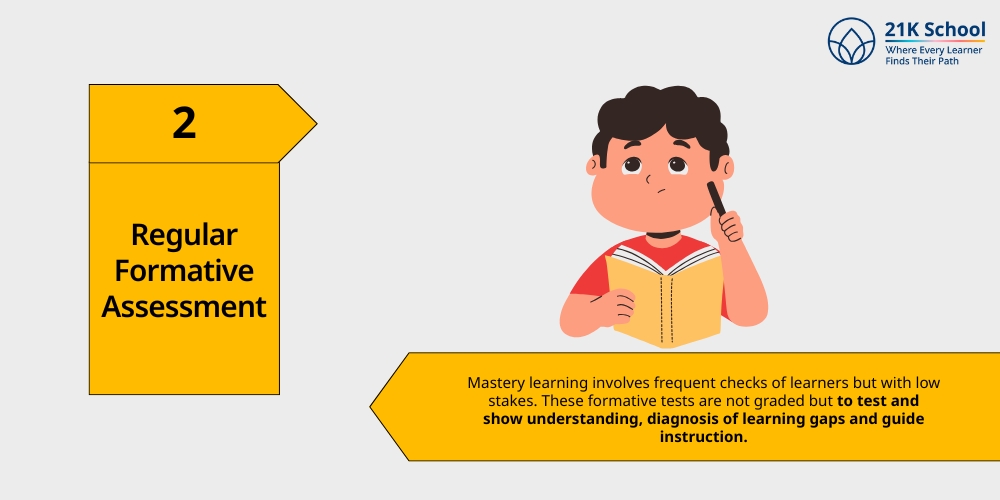
Mastery learning involves frequent checks of learners but with low stakes. These formative tests are not graded but to test and show understanding, diagnosis of learning gaps and guide instruction.
Teachers will be able to know who requires remedial attention and which concepts need to be re-taught. This is done by frequently testing the students throughout the learning process instead of at the end. Such tests are typically:
- Short quizzes
- Exit tickets
- Practice exercises
- Discussions or Actors in classrooms
These formative assessment tools make evaluation of learners way easier. They act as points of learning verification thereby making sure no pupil is promoted with false knowledge and confusion.
3. Corrective Instruction and Feedback
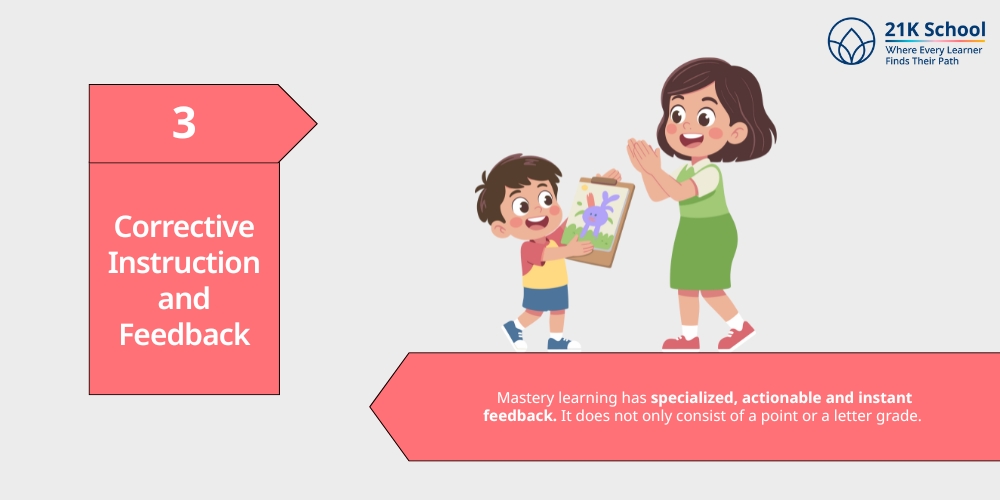
Mastery learning has specialized, actionable and instant feedback. It does not only consist of a point or a letter grade.
Rather, it also assists students in knowing what they did right, whatever they did wrong, and how they can do better. Learners who fail to do well during formative assessments receive corrective lessons. This can entail:
- Looking through the work with the teacher
- Participation of small-group session
- Doing extra practices
- Multimedia instructions/support or peer support
This is not to punish, but to help and nurture the learner through to the desired point of knowledge acquisition.
4. Clear Cut Learning Goals

The other fundamental principle of mastery learning is that there exist specific and quantifiable learning goals. These objectives give information on what students are supposed to know or be able to perform by the end of a lesson.
Clearly framed goals assist teachers and students to remain focused. It guarantees that teaching is consistent with evaluation and that students are aware of what they are supposed to do.
5. Well-defined learning outcome

Mastery learning will create clear outcomes of training. For example, students will be capable of using a balancing technique to solve equations involving one variable in linear equations.
When targets are unclear and general, perfecting them or giving specific help will be problematic. On the contrary, transparency renders teaching more efficient and learning more transparent.
6. Excellence rather than progress
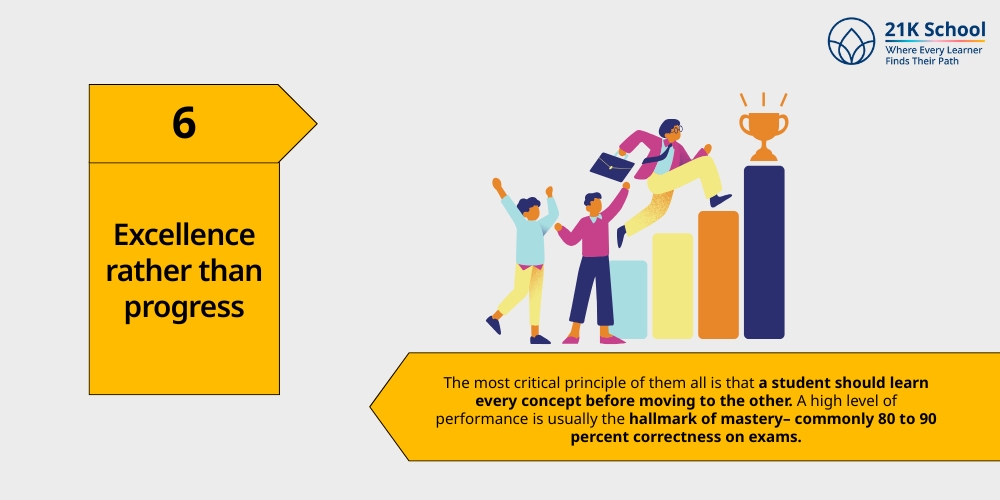
The most critical principle of them all is that a student should learn every concept before moving to the other. A high level of performance is usually the hallmark of mastery– commonly 80 to 90 percent correctness on exams.
This principle allows learning to develop on a very good foundation as opposed to gaps developing as learning progresses. Without mastering a simple skill, a student is likely to blend and fail at more complex ones as he or she proceeds.
This spirit of mastery:
- Avoids lifelong learning problems
- Raises student confidence and motivation
- Encourages an academic success and tenacity culture
Techniques of Mastery Learning
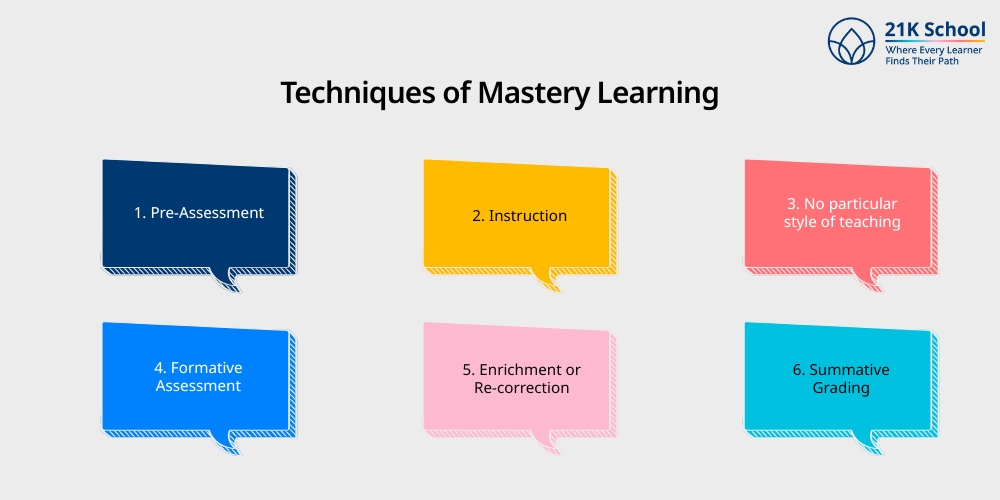
In order to use mastery learning, a step-by-step procedure consisting of various instructional methods is adopted by educators. These methods assist in guaranteeing that every learner gets the right support, time and opportunities to achieve mastery.
They are the most frequently utilized methods in a mastery learning model:
1. Pre-Assessment
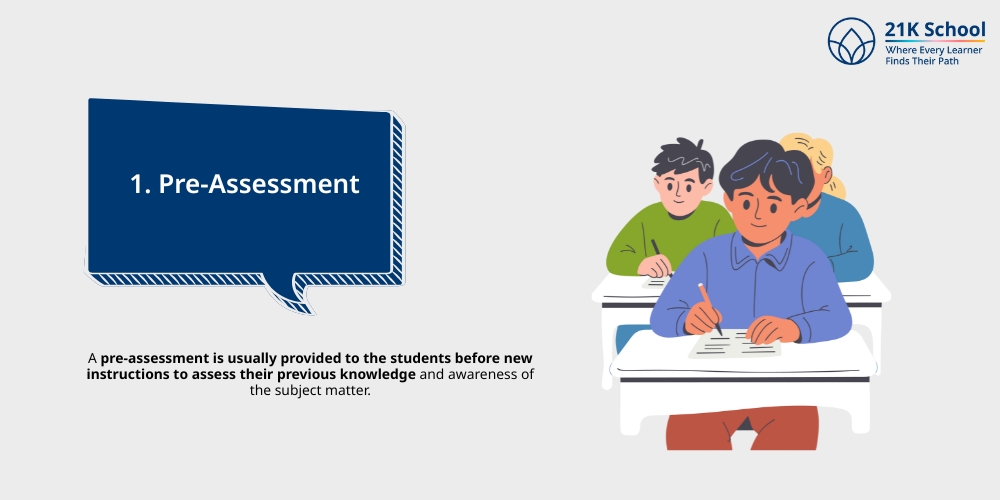
A pre-assessment is usually provided to the students before new instructions to assess their previous knowledge and awareness of the subject matter. This can assist the teachers:
- Discover who already knows the material,
- Identify areas of learning gaps,
- Differentiate instruction in regards to individual needs.
Also read about differentiated learning .
Pre-assessment is ungraded and can be used as a diagnostic instead of assessment. They assist the teacher in formulating the lessons as challenging enough and not repetitive in case of advanced learners.
Example: To assess who already knows the basics, a teacher tests his students in the form of a short quiz on fractions before moving onto a new unit.
2. Instruction
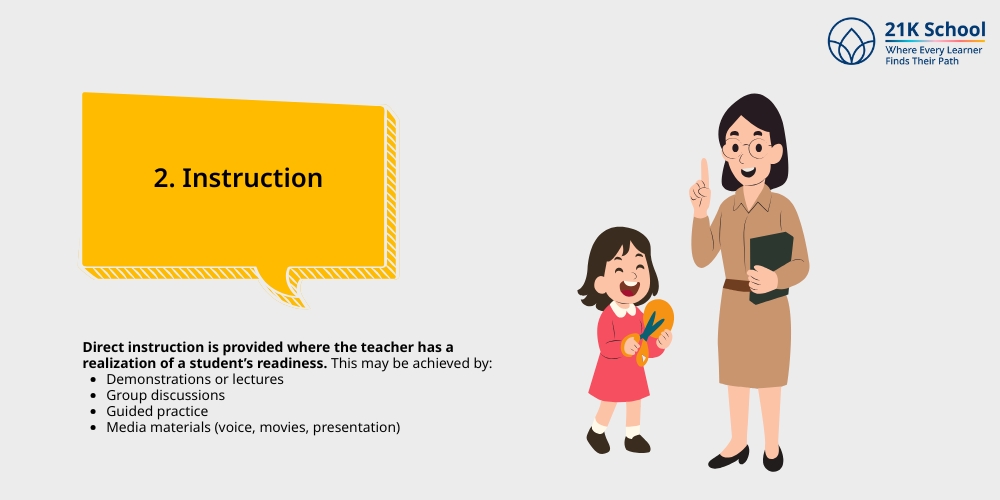
Direct instruction is provided where the teacher has a realization of a student’s readiness. This may be achieved by:
- Demonstrations or lectures
- Group discussions
- Guided practice
- Media materials (voice, movies, presentation)
The most important thing in this case is clarity and compatibility with learning goals. The teaching methods will be very systematic.
That too with the aspiration to present the material in small bits, and employ numerous techniques to appeal to various learning styles.
3. No particular style of teaching
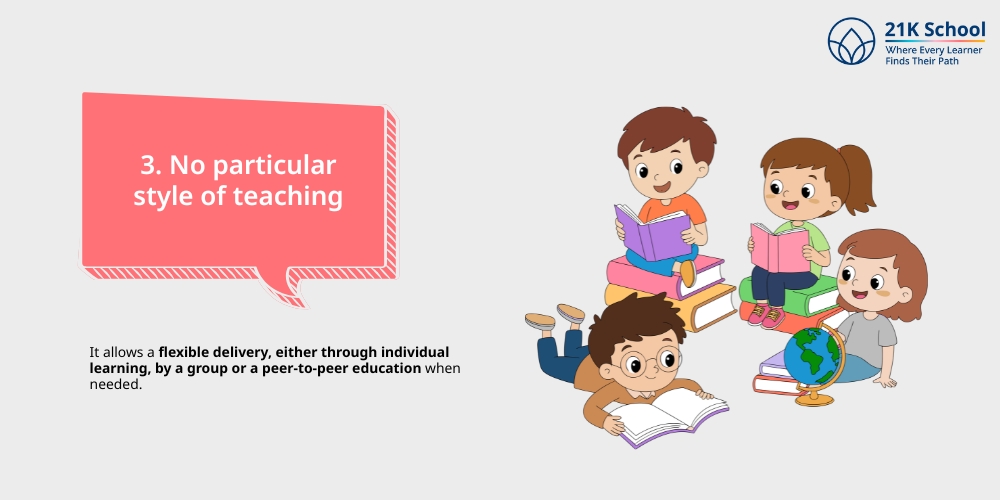
It allows a flexible delivery, either through individual learning, by a group or a peer-to-peer education when needed.
4. Formative Assessment
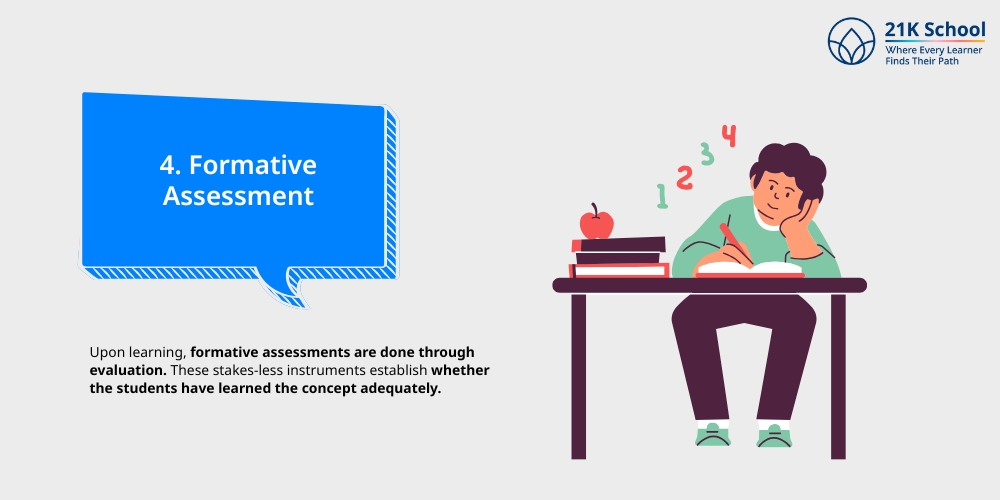
Upon learning, formative assessments are done through evaluation. These stakes-less instruments establish whether the students have learned the concept adequately.
Examples of formative assessment are:
- Quizzes
- Brief written conclusions
- Oral questioning
- Activities or games in the classroom
- Online tests (e.g. Google forms, Kahoot, etc.)
Formative tests are not like summative assessments; they are quite common and short-lived. They are applied to select whether a student is ready to proceed with their work or they need more assistance.
The students with low scores (below the specified limit which is usually 8-90 percent) are marked to receive remedial training.
5. Enrichment or Re-correction
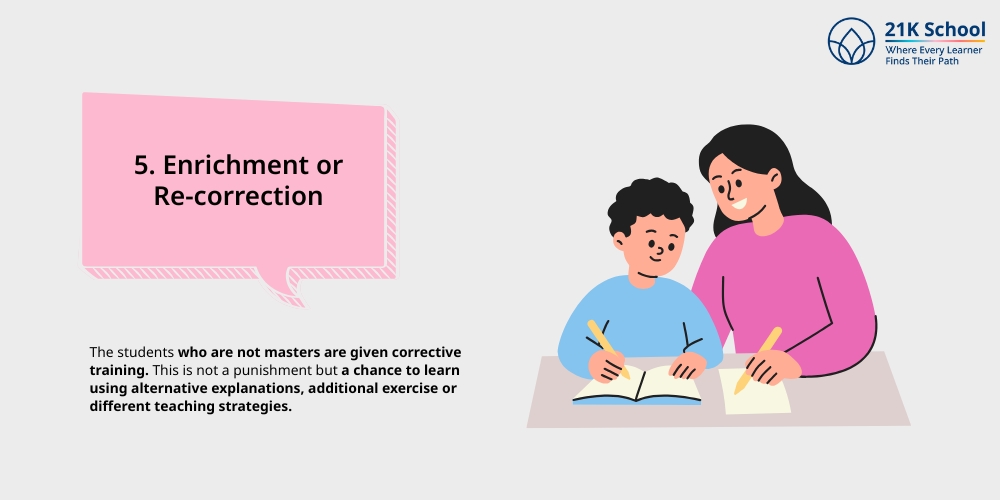
The students who are not masters are given corrective training. This is not a punishment but a chance to learn using alternative explanations, additional exercise or different teaching strategies. The correctional instruction can include:
- One-on-one tutoring
- Peer teaching
- Videos or worksheets
- Hands-on activities
Conversely, the students, who do manage to master it, are not left behind in idleness. Enrichment activities, which enhance their knowledge or enlarge their learning process, are provided to them. These could be:
- Creative projects
- Advanced problems
- Tasks of independent research
- Cross-disciplinary applications
It aims at personalizing learning among all students- making it remedial where necessary, and enrichment where possible.
6. Summative Grading
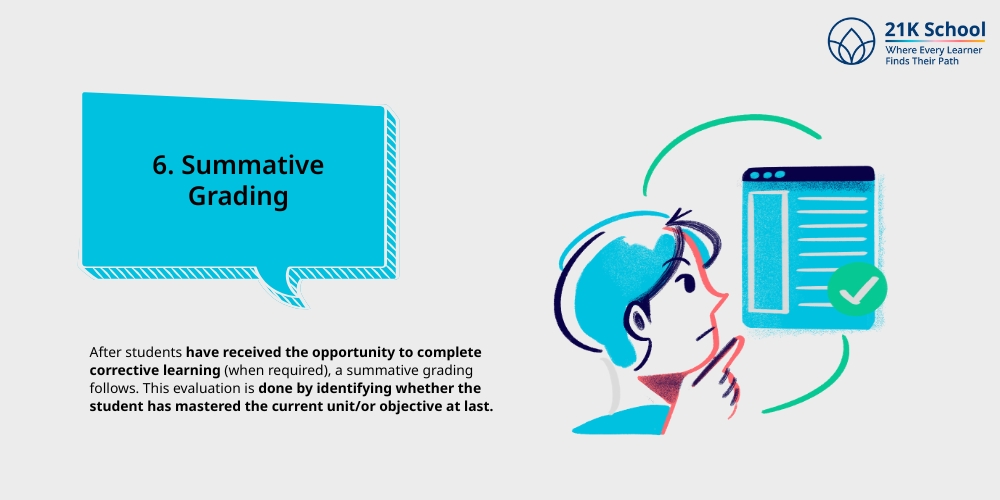
After students have received the opportunity to complete corrective learning (when required), a summative grading follows. This evaluation is done by identifying whether the student has mastered the current unit/or objective at last.
Summative assessments are graded usually and they signify the achievement of the student towards the end of the learning cycle.
Features of mastery learning good summative assessments:
- In accord with learning objectives
- Skills-based or performance-based (not rote memorisation)
- These were utilized in certifying mastery before passing to the next level
In traditional systems grades are usually an average of performance over time. In mastery learning, grading is final performance based, recognizing progress, and ensuring that the student knows.
Benefits of Mastery Learning

Mastery learning has numerous advantages to students and the teachers. This will help build an inclusive, equitable, and outcomes-oriented learning environment by focusing on individual improvement instead of relative performance.
Some benefits of mastery learning include the following:
1. Better Student Outcome

Mastery learning can lead to the best academic performance of students. As they are not allowed to advance until they are successfully able to infer deep understanding.
The learners will store fewer gaps in knowledge resulting in a better understanding, memory, and academic achievements in the longer term.
Research demonstrates that mastery instruction has a noticeable positive effect on achievement level on tests. And it is particularly effective in basic subjects such as reading and mathematics.
2. Promotes Growth Mindset
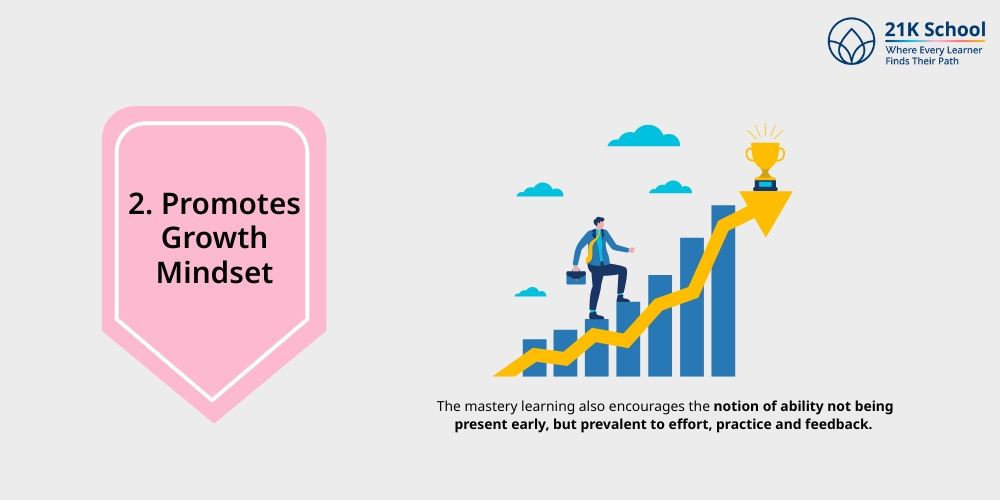
The mastery learning also encourages the notion of ability not being present early, but prevalent to effort, practice and feedback. The students get to know that failing is not the last point but it is a part of the learning process.
This transition between the fixed and growth mindset in education will promote perseverance, resilience, and overall liking of the challenges.
3. Individualized Learning Experience

Learning is individual and all students learn differently and mastery learning accommodates this fact. It gives an option of a personal pace and can offer personal feedback.
The fastest learners can advance or participate in extra-curricular activities . And those that need time get the support they require without lagging behind or feeling incompetent.
4. Fewer Dropout Rates
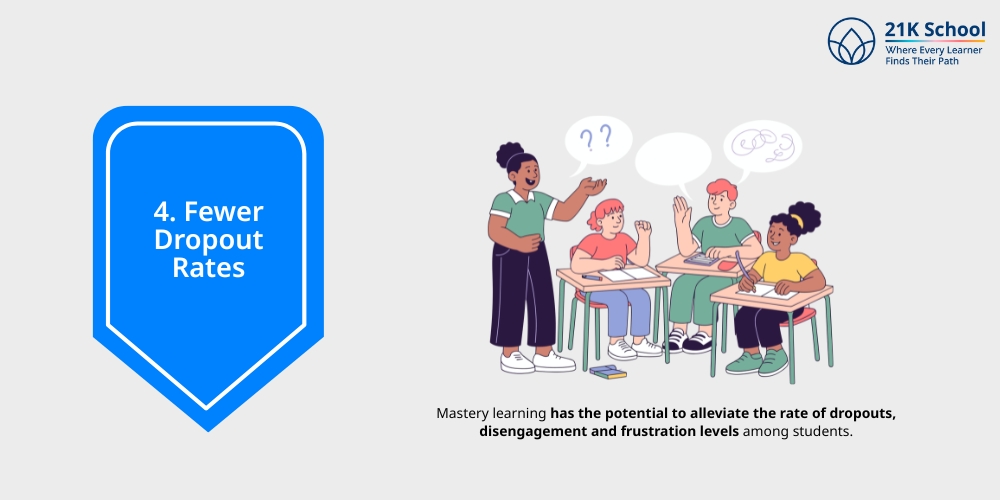
Mastery learning has the potential to alleviate the rate of dropouts, disengagement and frustration levels among students. This can be achieved by increasing the level of support and success orientation of such a learning environment.
Learners will be more involved in and committed to their education. Especially, when they feel understood and realize success with their instructors all the time.
5. Better Teacher-Student Relations
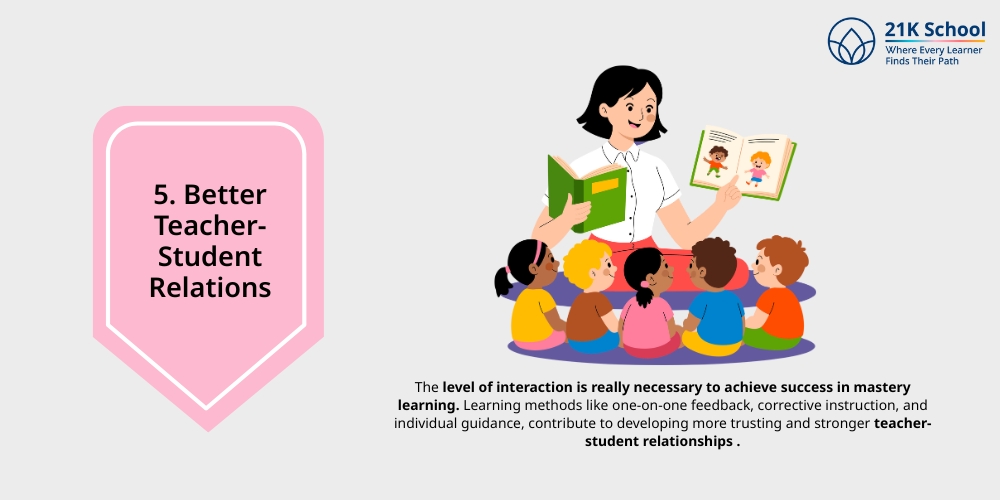
The level of interaction is really necessary to achieve success in mastery learning. Learning methods like one-on-one feedback, corrective instruction, and individual guidance, contribute to developing more trusting and stronger teacher-student relationships .
There is also a more collaborative classroom culture with the teachers acting as facilitators, and not merely as content deliverers.
6. Improved Real Life Readiness

Mastery learning imparts fundamental skills in life such as goal setting, self-evaluation, problem-solving and endurance. These are very transferable to colleges and the job market.
Students learn more than the minimum to pass and instead inculcate habits to learn and conquer genuine life situations.
7. Greater confidence in students
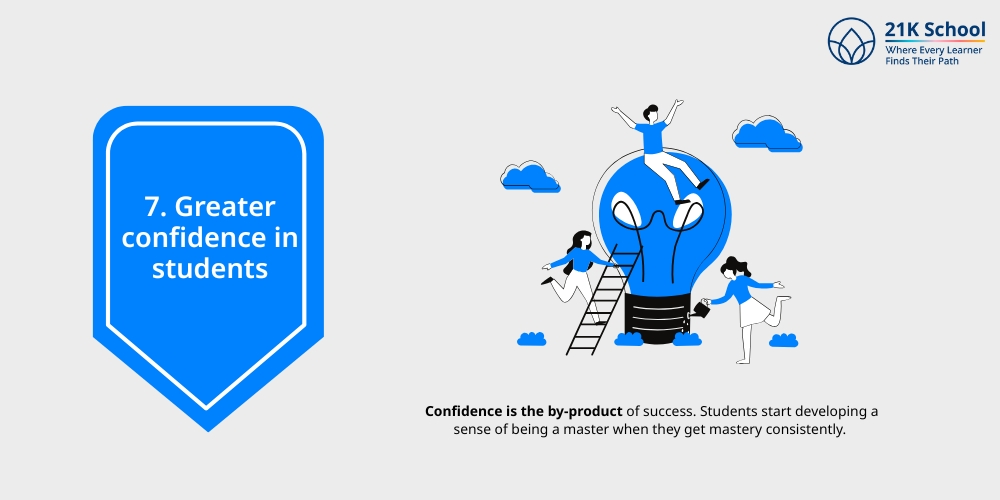
Confidence is the by-product of success. Students start developing a sense of being a master when they get mastery consistently.
Mastery learning inculcates ways on how to build confidence in children . This boosts self-esteem, lessens fear of failure and motivates participation in subsequent learning activities.
Examples of Mastery Learning inside the Classroom
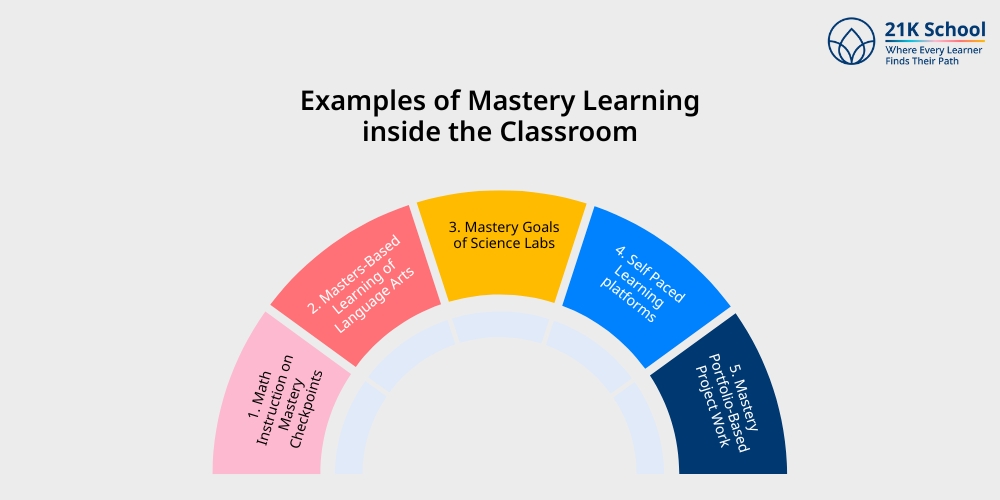
Mastery learning has the potential of being applied at grade levels and subjects. It may as well appear as follows in real classroom contexts:
1. Math Instruction on Mastery Checkpoints

The problem taking place in a math classroom of a middle school is the solving of linear equations. The teacher did not just hand out a worksheet to all students and go on after a single quiz:
- Offers a mini-lesson and explicit objectives of learning.
- Provides practice-set and short formative quizzes to students.
- Provides remedial training to individuals who did not at least get 85%.
- Has the option of reassessment following further assistance.
Students can only take the next unit- inequalities, upon mastering linear equation solutions.
2. Masters-Based Learning of Language Arts

Reading fluency rubrics are used by the teacher in an elementary reading lesson. Students are made to read aloud an item and a teacher evaluates on their pace, errors and the voice tone.
In case a student fails to satisfy the fluency criteria, he or she:
- Get guided reading
- Training on specific subjects
- Read a new passage and recheck when they are prepared
Fluent readers receive enrichment class activities such as book discussions, their own creative writing or tutoring members of their group.
3. Mastery Goals of Science Labs
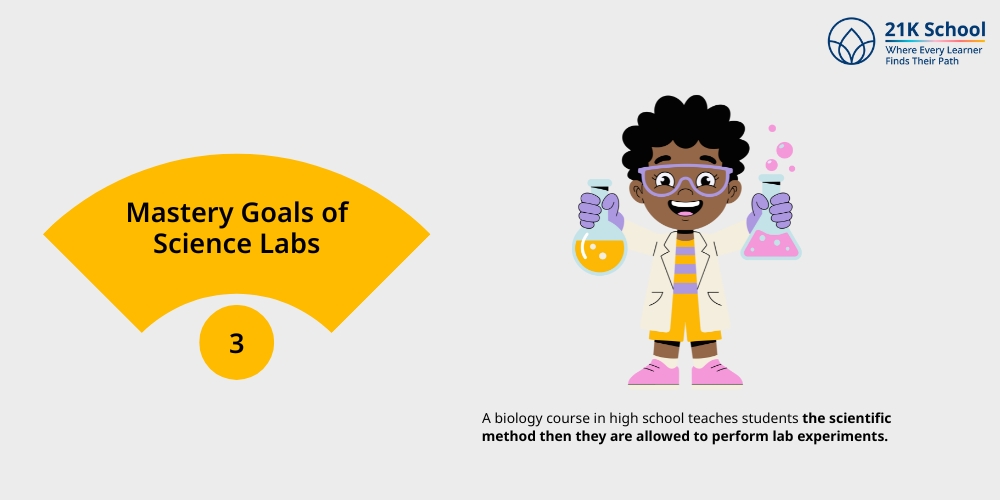
A biology course in high school teaches students the scientific method then they are allowed to perform lab experiments. It is done through:
- Pretest quiz that evaluated knowledge of hypothesis writing, variables and experimental design.
- Focal videos or professionally directed revision of students with problems.
- Students are not permitted to move on with the lab work unless they appear to be ready.
It means that all students are ready to do practical scientific experiments and decrease lab time mistakes.
4. Self Paced Learning platforms

Digital platforms and sites such as Khan Academy or Coursera employs mastery learning through:
- Grouping content in micro-lessons.
- Making students learn one ability before they gain access to the next (with 80-100 percent precision).
- Having corrective tutorials in the form of videos, hints, and exercise problems.
This is a model that allows the students to review the lessons as many times as they want and advance at their own pace.
5. Mastery Portfolio-Based Project Work
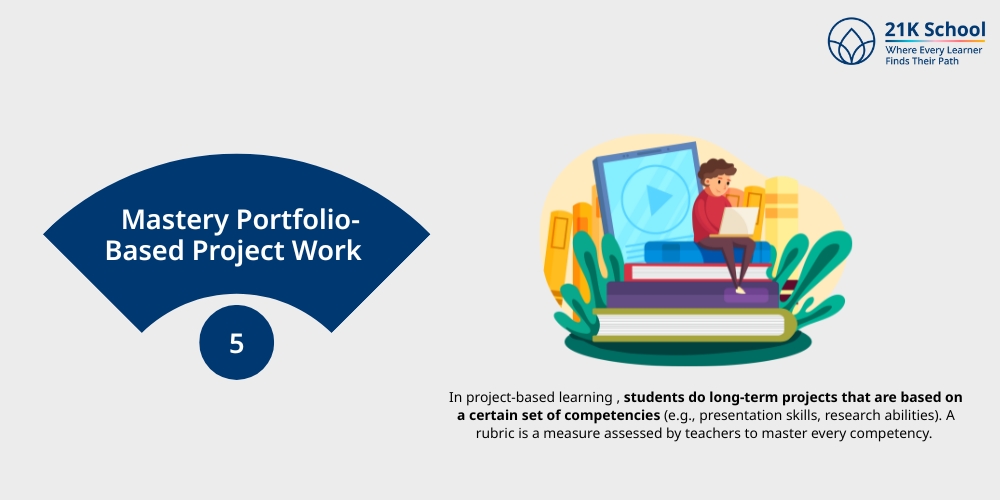
In project-based learning , students do long-term projects that are based on a certain set of competencies (e.g., presentation skills, research abilities). A rubric is a measure assessed by teachers to master every competency.
Students who do not pass in one aspect are advised to redo and re-submit their works till they can pass. These are some of the ways whereby mastery learning could be tailored to suit specific content areas and student needs.
The trick is that every learner has a purpose, numerous opportunities to learn, and systems that enable them to achieve mastery.
Competency-Based Learning Vs Mastery Learning

Competency-based education and mastery learning are often used interchangeably yet they are different educational approaches with similar philosophies. They both seek to make students grasp what they are learning properly before moving forward.
They are however different in their structure, scope and implementation. Let us simplify the analogy:
| Aspect | Competency-based Learning | Mastery Learning |
| Definition | Students progress once they master specific competencies or skills. | Students must fully master a topic before moving to the next. |
| Focus | Focus on mastering specific competencies or skills for practical applications. | Focus on mastering individual academic concepts. |
| Structure and Flexibility | Flexible, allows students to progress at their own pace based on mastery. | Structured, with sequential learning and fixed assessments. |
| Assessment | Continuous, competency-based assessments. | Periodic assessments to check mastery before progression. |
| Examples | Vocational training, personalized online courses. | Math programs, language arts mastery. |
| Time and Pacing | Flexible pacing; students progress when ready. | Fixed time for mastering concepts, but paced individually. |
1. Definition
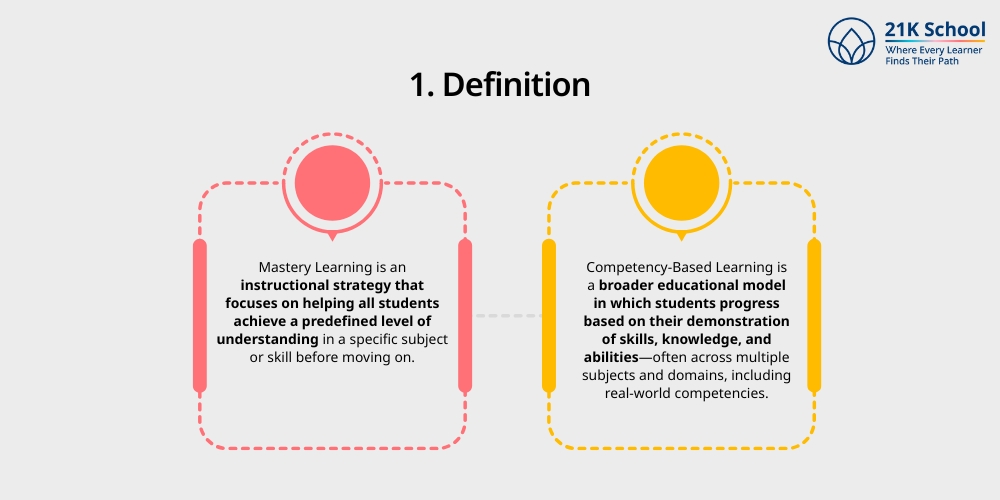
- Mastery Learning is an instructional strategy that focuses on helping all students achieve a predefined level of understanding in a specific subject or skill before moving on.
- Competency-Based Learning is a broader educational model in which students progress based on their demonstration of skills, knowledge, and abilities—often across multiple subjects and domains, including real-world competencies.
2. Focus
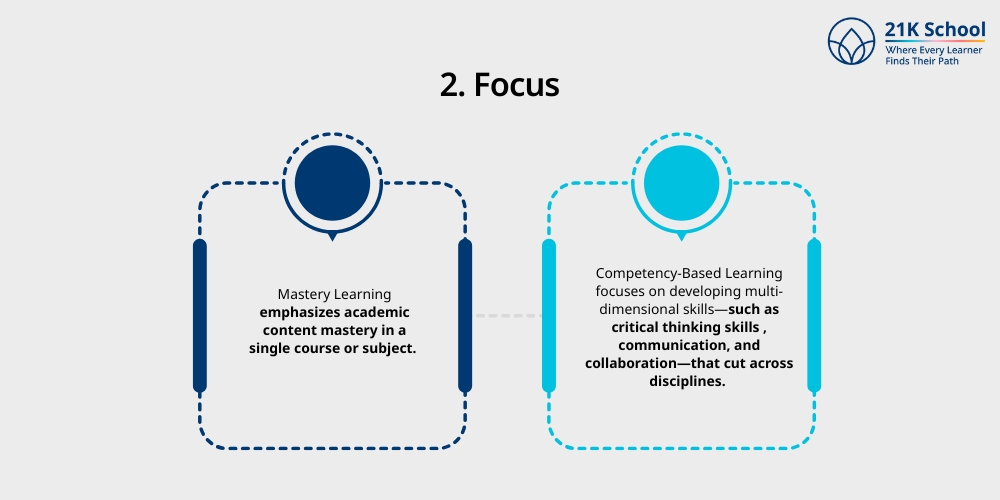
- Mastery Learning emphasizes academic content mastery in a single course or subject. For example, a student must master solving quadratic equations before advancing to polynomial functions in algebra.
- Competency-Based Learning focuses on developing multi-dimensional skills—such as critical thinking skills , communication, and collaboration—that cut across disciplines. A student’s progress may be tracked through performance on complex, cross-subject tasks or portfolios.
3. Structure and Flexibility
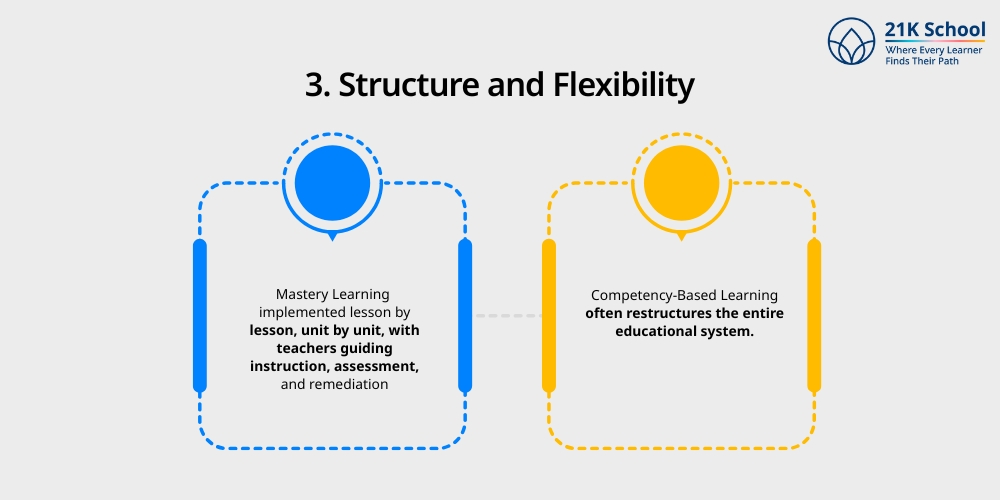
- Mastery Learning typically works within Traditional classroom structures. It’s implemented lesson by lesson, unit by unit, with teachers guiding instruction, assessment, and remediation.
- Competency-Based Learning often restructures the entire educational system. Students may work on learning interdisciplinary projects, progress at different times, and receive credentials based on actual skills acquired, not seat time or grade level.
4. Assessment
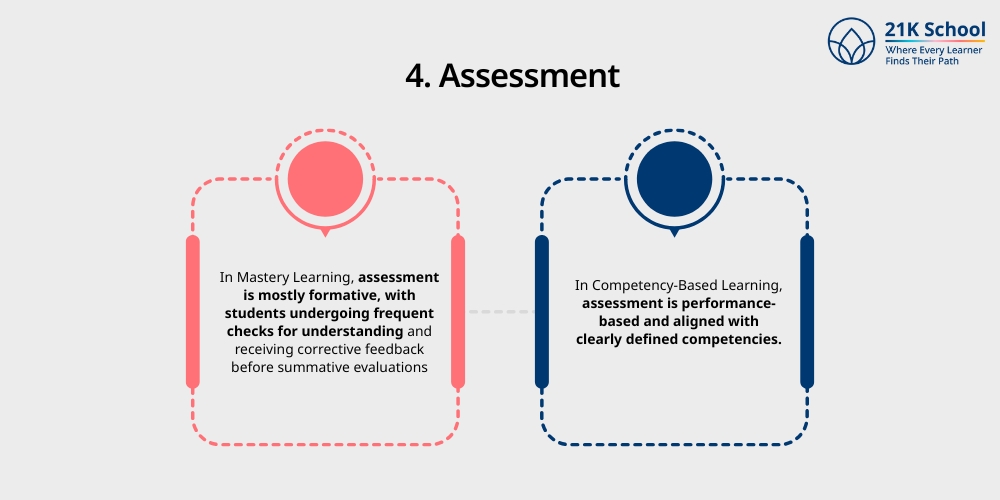
- In Mastery Learning, assessment is mostly formative, with students undergoing frequent checks for understanding and receiving corrective feedback before summative evaluations.
- In Competency-Based Learning, assessment is performance-based and aligned with clearly defined competencies. Students may show proficiency through real-world projects, presentations, or skill demonstrations rather than standard tests.
5. Examples
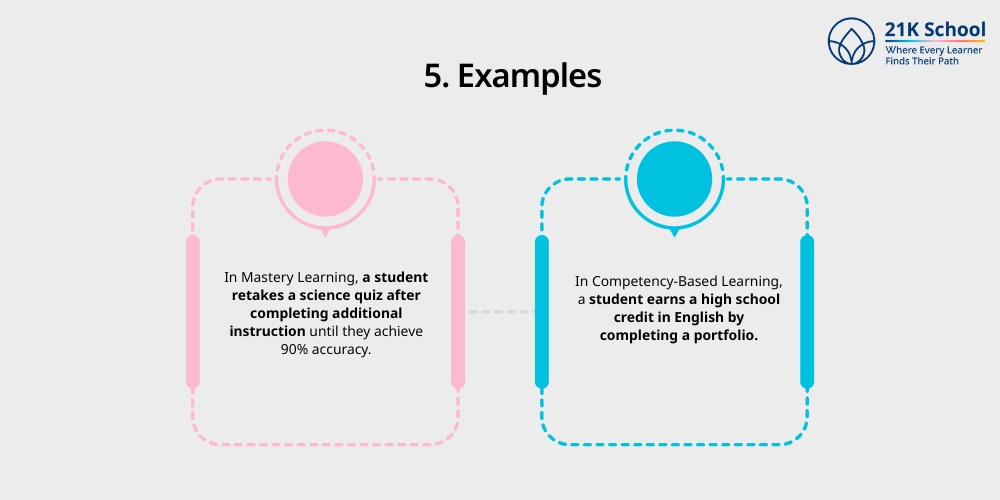
- In Mastery Learning, a student retakes a science quiz after completing additional instruction until they achieve 90% accuracy.
- In Competency-Based Learning, a student earns a high school credit in English by completing a portfolio. It includes written essays, a speech, and a peer-reviewed video presentation that meet specified communication competencies.
6. Time and Pacing
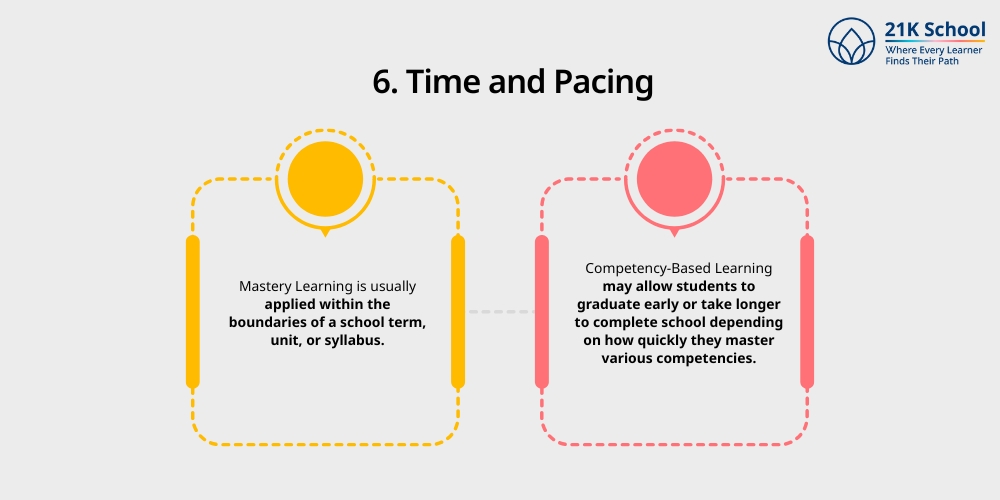
Both approaches allow for flexible pacing, but in different ways:
- Mastery Learning is usually applied within the boundaries of a school term, unit, or syllabus.
- Competency-Based Learning may allow students to graduate early or take longer to complete school depending on how quickly they master various competencies.
Challenges in Implementing Mastery Learning

While mastery learning offers many benefits, its successful implementation is not without obstacles.
Transitioning from Traditional schooling models to a mastery-based system requires changes in mindset, curriculum design, assessment practices, and classroom management.
Below are some of the most common challenges educators and institutions face:
1. Time and Resource Intensive
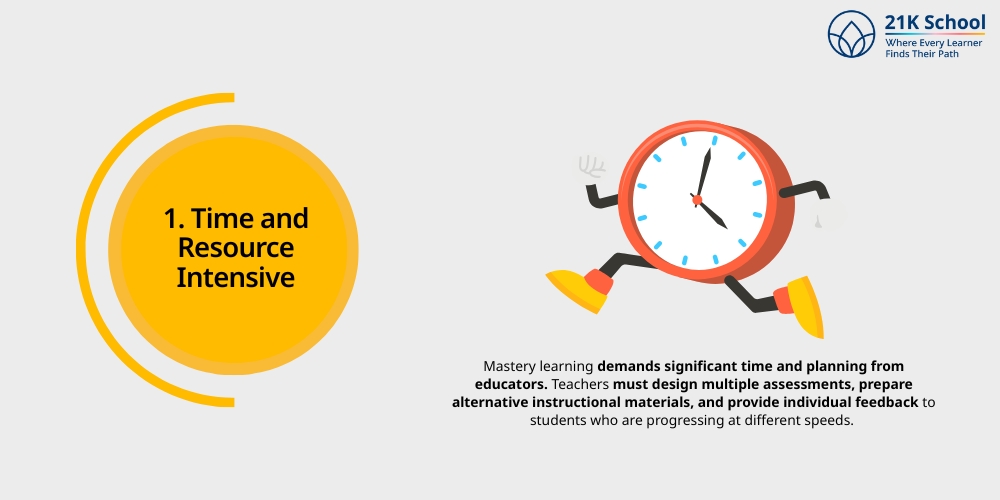
Mastery learning demands significant time and planning from educators. Teachers must design multiple assessments, prepare alternative instructional materials, and provide individual feedback to students who are progressing at different speeds.
This level of personalization requires:
- Extended preparation time
- More class time for reassessment and reteaching
- Additional instructional resources (videos, worksheets, tutoring)
In schools with large class sizes and limited staffing, providing this level of individual attention can be difficult to sustain. Therefore, educators must practice time-management skills .
2. Standardized Testing Resistance
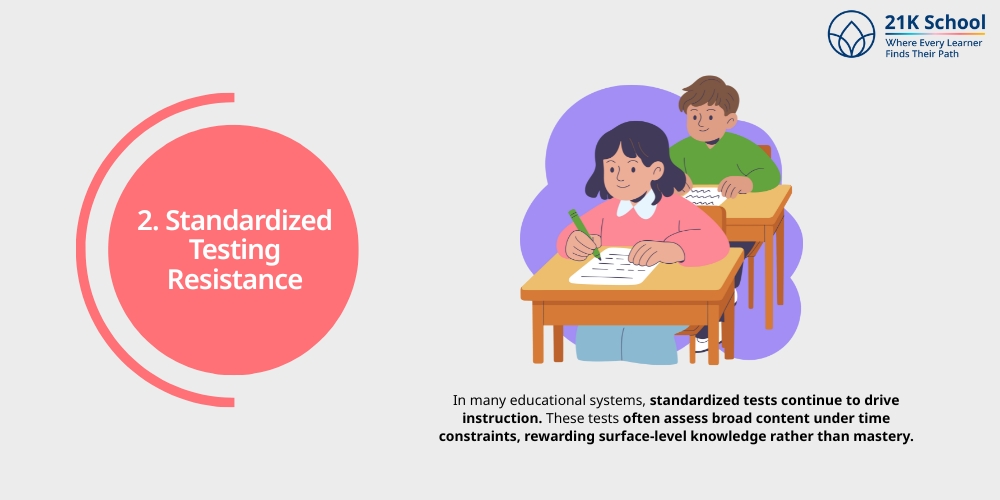
In many educational systems, standardized tests continue to drive instruction. These tests often assess broad content under time constraints, rewarding surface-level knowledge rather than mastery. Mastery learning, on the other hand, emphasizes:
- Depth over breadth
- Mastery of specific concepts
- Flexible pacing
This mismatch can create pressure on teachers to “teach to the test,” reducing the time and flexibility needed to implement a mastery approach. Schools that are heavily performance-ranked by standardized exams may hesitate to adopt mastery learning fully.
3. Classroom Management
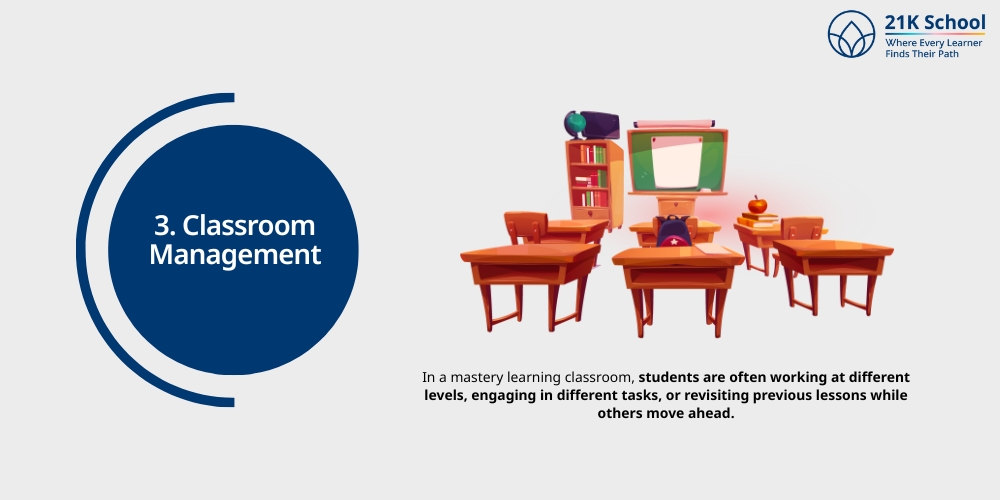
In a mastery learning classroom, students are often working at different levels, engaging in different tasks, or revisiting previous lessons while others move ahead. This makes classroom organization and management more complex, especially when:
- Students require varying degrees of supervision and support
- Group work and peer tutoring are used frequently
- Technology is integrated for self-paced learning
Teachers need strong classroom management skills and a clear system to track student progress and provide timely feedback. Without structured routines, the classroom may become disorganized or difficult to monitor.
These challenges do not imply that mastery learning is unworkable. But rather that it requires institutional support, professional development , and a shift in priorities.
When schools provide resources, training, and time for implementation, these barriers can be addressed effectively.
Integrating Mastery Learning with Advanced Educational Opportunities
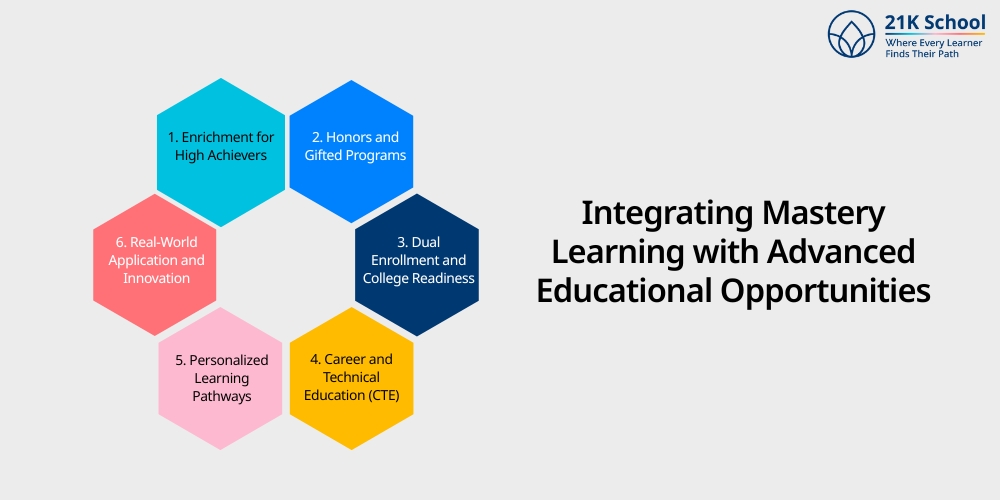
Mastery learning is not just a remediation tool for struggling students. It can also serve as a foundation for advanced educational opportunities.
When students are encouraged to deeply understand concepts and skills, they become more capable of taking on enriched, interdisciplinary, and real-world learning experiences. Here’s how mastery learning can be integrated into advanced education:
1. Enrichment for High Achievers
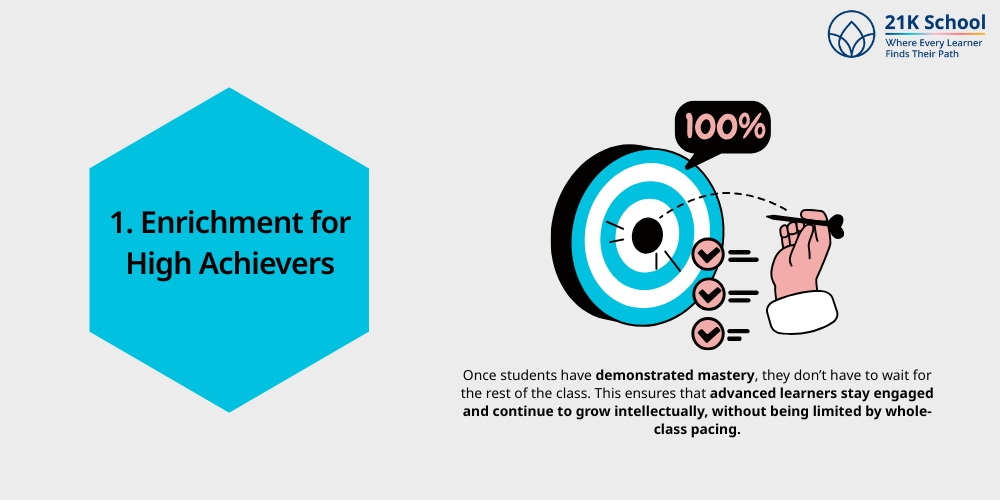
Once students have demonstrated mastery, they don’t have to wait for the rest of the class. Instead, they can be offered extension activities, such as:
- In-depth research projects,
- Creative assignments (e.g., designing a model, writing a report),
- Cross-curricular challenges (e.g., applying math to science or real-world problems),
- Leadership opportunities like mentoring peers.
This ensures that advanced learners stay engaged and continue to grow intellectually, without being limited by whole-class pacing.
2. Honors and Gifted Programs
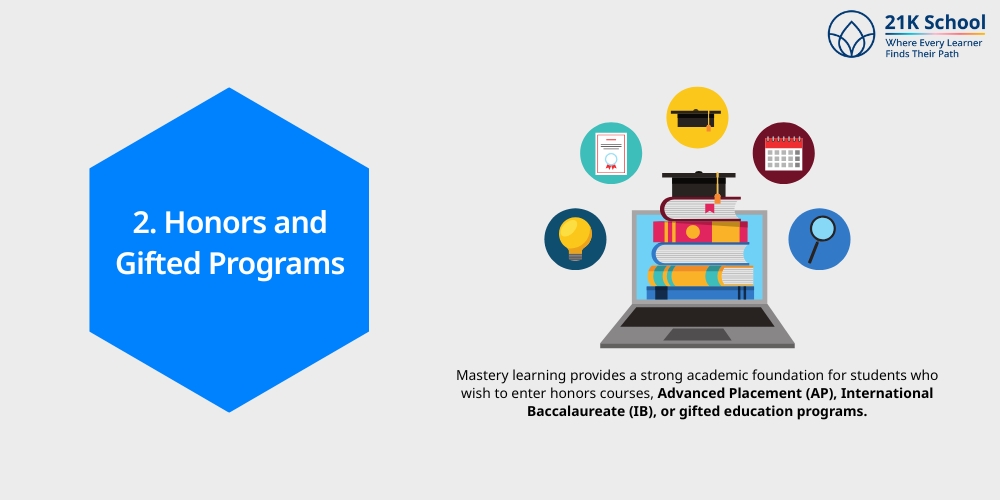
Mastery learning provides a strong academic foundation for students who wish to enter honors courses, Advanced Placement (AP), International Baccalaureate (IB), or gifted education programs. These programs often demand:
- Independent learning
- High levels of comprehension
- The ability to apply knowledge in unfamiliar or complex scenarios
By mastering fundamental concepts beforehand, students are better prepared for the rigor and pace of advanced academic tracks.
3. Dual Enrollment and College Readiness
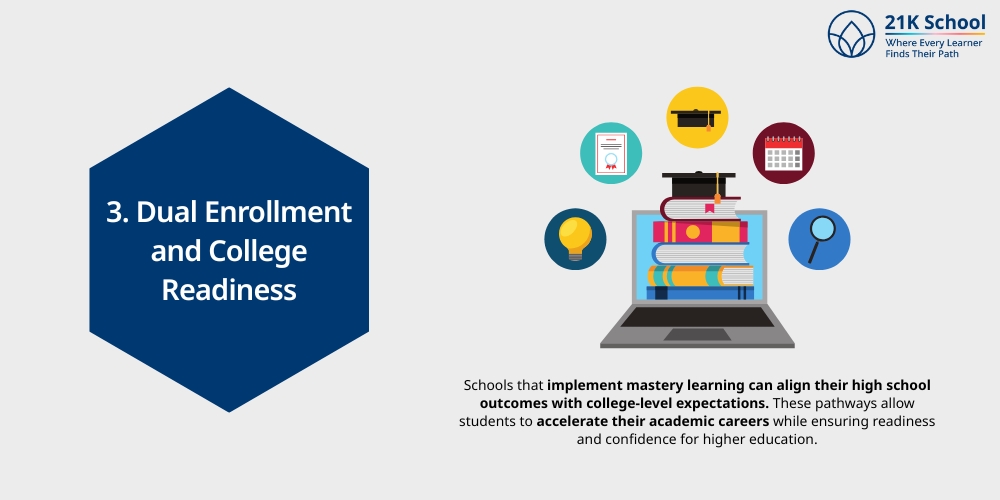
Schools that implement mastery learning can align their high school outcomes with college-level expectations. Students who demonstrate early mastery in subjects like math, science, or English may be eligible for:
- Dual enrollment programs, taking college courses while in high school,
- Early college entrance opportunities,
- Advanced placement or testing out of entry-level college courses.
These pathways allow students to accelerate their academic careers while ensuring readiness and confidence for higher education.
4. Career and Technical Education (CTE)
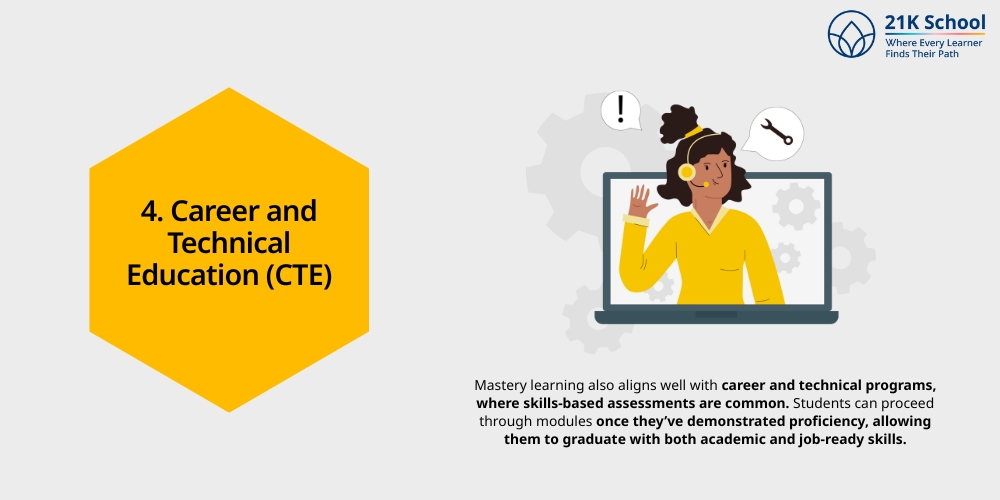
Mastery learning also aligns well with career and technical programs, where skills-based assessments are common. In CTE settings, mastery might be demonstrated through:
- Industry certifications
- Hands-on projects
- Portfolios and performance tasks
Students can proceed through modules once they’ve demonstrated proficiency, allowing them to graduate with both academic and job-ready skills.
5. Personalized Learning Pathways

Advanced learners benefits from personalized learning , where they can:
- Choose elective topics of interest
- Set their own learning goals
- Design independent study projects
- Use online platforms to explore subjects not offered in school
Mastery learning tracks progress based on demonstrated understanding. It supports these personalized paths by giving students the freedom to go deeper once they’ve completed core requirements.
6. Real-World Application and Innovation
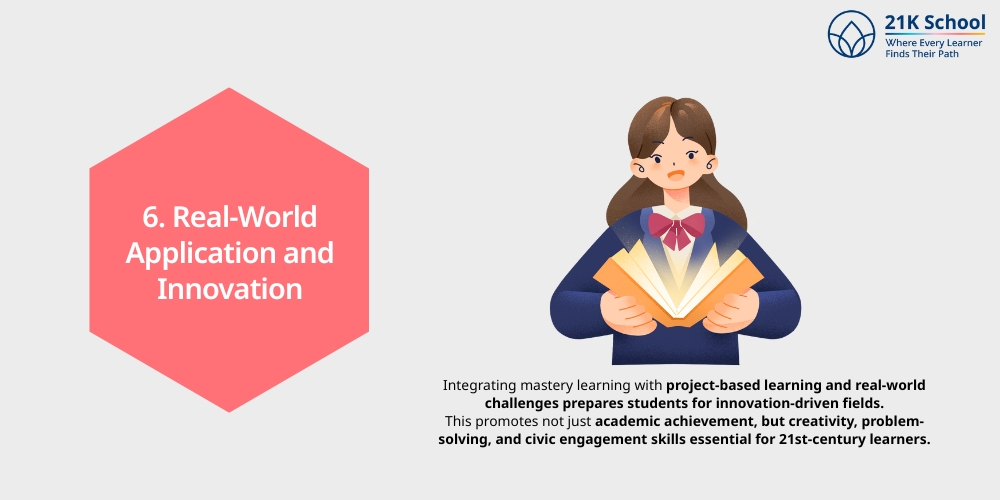
Integrating mastery learning with project-based learning and real-world challenges prepares students for innovation-driven fields. Once basic concepts are mastered, students can engage in:
- Entrepreneurial projects
- Science fairs
- Coding competitions
- Community service initiatives
This promotes not just academic achievement, but creativity, problem-solving, and civic engagement skills essential for 21st-century learners .
Concluding Comments
Mastery learning redefines success in education by focusing on understanding rather than speed. It ensures that every student, regardless of background or ability, receives the time, support, and instruction they need to master key concepts.
This method promotes equity, confidence, and academic excellence. Basically, it does that by shifting classrooms from pressure-driven environments to growth-focused learning spaces.
Though it requires more planning and flexibility, the long-term benefits make it a transformational approach. These advantages include improved outcomes, stronger teacher-student relationships, and readiness for future challenges.
Mastery learning doesn’t just teach content—it builds capable, resilient learners prepared for lifelong success.
Read the success stories of top inspiring individuals here to get motivated.

